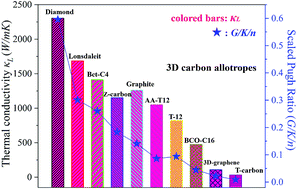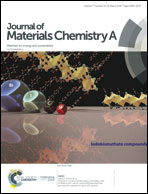Ultrahigh thermal conductivity of carbon allotropes with correlations with the scaled Pugh ratio†
Abstract
Electrical insulators with ultrahigh thermal conductivity (κL) are highly desirable for thermal management to facilitate heat extraction in many electronic devices. In this work, we select three typical carbon allotropes (lonsdaleite, Bct-C4, and Z-carbon) with ultrahigh κL from the 522 carbon allotropes in the Samara Database by using Boltzmann transport theory combined with first-principles calculations. We find that the thermal conductivity (κL) of the three carbon allotropes is 1686.67, 1411.02 and 1262.05 W m−1 K−1, respectively, at room temperature. A further analysis of both harmonic and anharmonic properties reveals that such high κL is attributed to their exceptional atomic structures. They all are composed of pure sp3 hybridized carbon with a short bond length, small unit cell and strong chemical bonding. Together with diamond, they are the top four κL materials (beyond 1000 W m−1 K−1) reported so far among the 3D carbon allotropes. Equally important, we propose a simple descriptor, namely the scaled Pugh ratio (G/K/n), to characterize the strength of chemical bonding for high-throughput thermal material screening. The three identified carbon allotropes in this study would be alternatives to diamond in future thermal energy devices.



 Please wait while we load your content...
Please wait while we load your content...